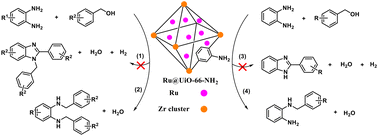Developing efficient heterogeneous catalysts with high metal dispersion and good reusability is crucial for C–N bond-forming reactions via hydrogen-borrowing methodology. Herein, a metal–organic framework, (MOF) UiO-66-NH2, was used as an ideal support to encapsulate Ru nanoparticles (Ru@UiO-66-NH2) via a simple impregnation–reduction method. Comprehensive characterization using various techniques such as XRD, TEM, HAADF-STEM, XPS, and ICP-AES revealed that atomically dispersed Ru particles were confined in the MOF cavities. Ru@UiO-66-NH2 was then applied for selective N-alkylation of o-phenylenediamines with benzyl alcohols to amines, thereby avoiding the generation of benzimidazoles. A wide scope of this reaction with a variety of anilines and alcohols bearing different functional groups were explored. Owing to the metal–support interactions and high surface areas, the combination of Ru nanoparticles and UiO-66-NH2, acting as active sites for the activation of amines and transfer of hydrogen, resulted in excellent catalytic activity.
